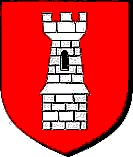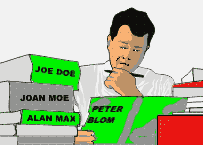
|
C/S Tools: |

|
C/S Tools: |
C/Sing Engram Running

Before starting or continuing a pc on Grade 5 this FES Summary List should be completed and needed set-ups indicated should be done.
Handling Engram Running and Engram Clearing as a Case Supervisor is relatively simple. The reasons for this are, (1) all Engram running basically builds on the use of only one process, R3RA, Engram running by Chains. (2) In repairing any problems, failed sessions, TA problems, etc. you use more R3RA processes and remedies to do it with.
Grade 5
The basic program or outline for Grade 5 is given in the chapter Engram
Clearing, Full Program. A copy of the Steps should be used
in the pc folder to keep track of his progress. When one step is completed or
examined for completeness, it is simply checked off as having been done.
The Full Program lists 17 steps. Many of them, such as Step 2-6, should already have been done on the pc as part of earlier auditing. Several of the later steps are only done as needed (optional steps). Step 1, The Pc Info Sheet, is always done. This is the basic interview and inventory of pc's difficulties and complaints, that you handle in Engram Clearing.
Each Step on the Full Program is, even when previously done, looked into.
Example: Pc Joe has come up through the all the Grades and is ready for Engram Clearing. First the Pc Info Sheet is done by the auditor. Now the C/S goes to work for real. He examines the Pc Info Sheet and he examines pc's folder.
Step 1: "Pc info Sheet" was done right away.
Step 2: "Handle any PTS Symptoms" only takes folder study in Joe's case. There are no PTS symptoms in PT. Pc had a PTS RD two years ago and it worked out. There is no reason to do anything, except write down the observations, include it as a written statement in the folder and check it off on the program. The C/S noted however, that the R3RA Steps of the PTS RD wasn't done.
Step 3: The Cleansing RD is quickly reviewed. How was pc's success story? How long was he on the program? Any difficulties during it? It looks fine from the folder, the conclusion of the study is briefly written up and Step3 is checked off.Step 4: The Recall Drug RD looks OK and is checked off.
Step 5 and 6: Joe was audited on the line-up of Objective processes as given on CT-1. The C/S would ensure the Objectives were not done Quickie and that actual Objectives EP's were obtained. What was the pc's success story at the end? It looks fine. The C/S writes it up briefly and checks Step 5 and 6 off. Doing the full line-up of TR 0-4 and 6-9 are also listed on the Grade Chart under Objectives and the C/S ensures this was done.Step 7: Engrams, Basic Definitions. Joe has read the CT-5 pack. Yet the C/S wants to make sure he understands all the basic definitions and has no misunderstood words in these. He orders the auditor to go over Engrams, Basic Definitions with the pc in session. Also, auditor clears all the words in the R3RA commands, Pre-assessment procedure and the words from the correction list, L3RH. It's a lot of theory. Yet, Joe has several cognitions from going over and demonstrating the basic definitions and is happy.
Step 8: Engram Drug RD. Joe has a drug history of taking some street drugs, including using pot regularly over a number of years and cocaine at a few occasions. He also used alcohol regularly. He has been a user of pain killers as well and other medical drugs. He already had a successful Recall Drug RD, but it is time to find the Engrams and run them out. He is given a full Narrative handling of the drugs taken.
According to C/S Series 82 the question to "pc Interest?" is omitted when handling drugs. The requirement for running an item is, that the item or command read. The reason for this is, that failed Drug RD's have been traced back to, that reading Chains weren't run due to no "Pc Interest". Possibly the pc meant, he wasn't interested in drugs anymore. When writing a C/S for an Engram Drug RD session the C/S makes sure to include this instruction on each:"Omit asking for interest on R3RA drug items. Run them if they read on the Meter."
After completing the Narrative Step
the Pre-assessment step and Prior Assessment step are done per the Engram Drug
RD. Joe runs deep and well on this. He finds basic incidents on his whole track
with postulate gone and full erasure. He is excited about it. On the Prior
Assessment step he finds the real reasons he started to "experiment
with" and take drugs in the first place.
The last step of the Engram Drug RD is "more Objectives". From looking
at pc's earlier Objectives program it becomes clear, he was never run on
Standard Opening Procedure SOP-8C
and C/S orders that as the Objectives step.
Other Objective processes than those
on CT-1 exists. Additional Objective processes can
be found On-line with this link: Objective processes.
The processes listed as "Havingness
Processes" in CT-0 can sometimes be enough to get pc in present time.
The next Step on "Full Program" is Relief RD. With drugs completely handled, with the Engram Drug RD, the C/S however decides to catch up on something the folder study revealed. Joe has earlier had the PTS RD and the Service Computation RD done, but both without the R3RA steps. Now is a good time to catch up on this. We are going for Erasures here on Engram Clearing, not just key-outs. The PTS RD was done 2 years ago; the Service Comp RD just recently. The C/S orders the R3RA steps of PTS RD done. Here "Pc Interest" is of course checked. This is an extra insurance, that items actually long gone are not over-audited. When that is complete, the R3RA steps of Service Comp RD are done. PTS RD, R3RA steps and Service Comp, R3RA steps are each attested after completion. Each attest is to the C/S a confirmation of that the pc is fully with the program. If not it would have to be fixed right there.
(Another action that includes R3RA in full handling, the pc may have had, is Green Form 40, Resistive Cases. Many of the items there include R3RA for full handling. If they have been handled in the past without R3RA it should be looked into. Finding and erasing the basic Engrams leading to "Resistiveness" may be very rewarding even now. You may think, that the Engram Clearing program becomes endless this way; but it doesn't. As a C/S you simply want to be methodical and in an orderly fashion complete all earlier cycles on the case. Doing it this way ensures the important Chains, which bothered the pc in the past, are completely taken care of. As it usually goes, the pc will at some point of the whole possible program originate, that he thinks he went Clear, at which point to find this out for sure becomes the issue.
Also the Int RD can be run with R3RA, but you would only go into this, if you find the pc has Out Int while being on the Engram Clearing level. This could come up on an L3RH assessment.)
Down the Steps: So you take Joe through all the Steps of "Full Program" this way. You only apply the optional steps and the remedies if Joe's case indicates any need for it. You want to find the hot and bothersome Engram Chains first of all. So don't beat Joe to death with something he doesn't need. There are hundreds of Chains available (counting 4 flows) on an average Engram Clearing pc. A handful of the right basic Engrams erased will be the ones to remember. You may hit an Engram millions of years ago "which exactly matches PT dangers" and Joe will never be the same. There is no reliable way of guessing this. The methodical approach, completing cycle after cycle, is how Joe knows he is in good hands and his case being handled. It's the formula: "Auditor + Pc + C/S is Much Greater than Pc's Bank" at work.
C/Sing One Session
When the C/S goes over the session reports it is basically done by the
chapter, C/Sing Folders. There are
some specific things an Engram Clearing C/S should be looking for, however. Lets
just look at Step 1-5:
"1. First he looks at the Examiner Report. From that he can see what the pc thought about the session. It should be F/N VGIs and hopefully with a brief positive statement from pc."
"2. Then he looks at his instructions for the session to see what was supposed to be done. He then looks thorough the session report to make sure the auditor actually carried it out. He checks each step to see it was done.""3. Then he reads the work sheets. He checks that each process was correctly done, the right commands used and each action carried to EP."
Here the Engram Clearing C/S looks at, that the basic Engram erased was the basic to the Running Item. Sometimes pc's jump Chains, usually as a result of poor or incorrect Assessment.Step 4 was:
"4. If there are any Listing and Nulling actions he inspects this action carefully as "Out-lists" can be very upsetting to a case."
The C/S can use this to remind himself of, that badly done Running Items Lists can have the effects of Out-list on a pc.
Step 5 was:
"5. He checks that each process run was taken to the correct EP and that the whole session was ended of on F/N VGIs."
Here the C/S has to inspect the EP's closely. He is going for erasures with R3RA. Did a postulate at the time of the incident come off? Or did the auditor take a general cognition as "the postulate"?
The C/S grades the session per "C/Sing Folders".
In training and cramming auditors the special Training Drills TR 100-104, which drills the procedure, commands and all possible situations, is commonly used. Speed and certainty is very important when handling pc's and their endless Time Tracks. These TRs are thus routinely part of any Cramming Order, after missed materials and misunderstoods are handled.
Repairing R3RA Sessions
The primary repair tool in Engram running is L3RH. That is the correction list
for all Engram running. In repairing bad sessions and BI pc's you want to stay
with R3RA tools if at all possible. Engram running is its own. You don't go for
key-out any more. You assume that any Bad Indicators or bad session results were
caused by earlier Engrams restimulated but not erased. These Chains are
found by using a L3RH, by using the Remedies for Masses and Pictures and for
running out bad sessions. You could say you are conducting a relentless attack
on the basic Bank. To suddenly shift to key-out techniques is not getting you
there.
This approach has to be tempered with common sense, however. If your pc suddenly got sick you don't want to overwhelm him more. L3RH is your first tool if you suspect bad auditing could be the cause. Touch Assists, Locational processes and havingness of CT-1 and CT-0 are more applicable than subjective Assist processes. The ultimate tools should all be R3RA tools, of which there are many in the chapter, Illness, Health and Auditing.
"Rehab" and Engrams
Sometimes the complete erasure of certain Chains are in question. If the pc has
had Engram Running, 1950 Style, or had Engrams run while he was sick or under
the influence of medical drugs erasure of basics were not a sure thing. If
Engrams were run over unhandled drugs the same could be said. So how do you
"rehab" something that hopefully erased?
One rehabs an Engram Chain that erased (according to session reports) by saying,
"According to session records (flow direction) (item) erased." One
does it as a statement, never as a question. One can say, "Do you agree
that the Chain giving another a headache erased?" But the more you ask the
pc to
look for an erased Chain the more messed up things will get. It isn't there. If the statement of this
does not F/N (with pc's ruds already in) you simply assess a L3RH to find the
BPC.
It is a bit risky to try to handle old erased Chains. You would never use rehabs, such as Rehab by Counting or Rehab by Buttons. What you do is indicating it erased; the best you can do is to tell the pc what the old reports said. If no written record exists leave the already erased flows alone. Any BPC will be handled by more Engram running, including L3RH.
Incomplete Chains
At times a Folder Error Summary will show incomplete or flubbed Chains. An
FES'er may not be able to see it was ever repaired. Horror! Occasionally it was
just left there - incomplete. A
C/S and auditor would have been pretty irresponsible to just go on auditing past
Chains that never EP'ed. The
only safe way to handle previous flubbed Chain is to:
1. Check in the folder to see if it was repaired.
2. If not, assess an L3RH on it and handle accordingly.
Engram Running and Grade 0-4
Historically Engram Running was developed before the Grades 0-4. Grades and
processes, such as Recall Grade, Objective processes and many more, are in part
used to raise pc's confront so they are able to run Engrams. They also have
other benefits, of course. Some pc's can however run Engrams without having the
Grades first. Before 1981 Engram Running was done before Grade 0. Especially
pc's without a significant drug history can do very well on this. Engram
running, 1950 Style, is still widely in use as an introductory service and in
some areas it's the only auditing available. You won't get 100% success with
only that; but you will from time to time produce some remarkable successes.
What we are getting at, as far
as C/Sing R3RA is concerned, is that remedies, Assists and handlings, such as
PTS RD, Service Computation RD and Green Form 40 points can be done with R3RA at
other points than as part of Engram Clearing. It would take the step of educating
the pc before the first time you use R3RA.
Commonly a full "Engrams, Basic Definitions" (C/S 1) is done at Grade 4 and
then the Service Computations are run with R3RA. Obviously Engram Clearing is
the very next Grade. Engram Running has thus never been a "Grade 5
Only" service, as well as ARC break handling has never been a "Grade 3
only" service. If it seems to be the right thing and the pc is up to it,
R3RA Assists and parts of RD's with R3RA should be done. The question the C/S
has to ask himself is, "can the pc run it?" This will in part depend
on pc's drug history and be determined by how well the pc runs in general. Can
he run track? Does he get Somatics turning on and off? If all this seems to
indicate that pc can run it, go ahead. Erasing the basic Engrams is what produce
permanent results.

|
Each Chain is erased and |
Has Pc Gone Clear?
This is the ultimate question. We are sorry, we are not going to answer it in
great length here on CT-5. The chapter "State of
Clear" is the best reference. What is important to know is, that huge
wins are available to pc's on Engram Clearing. This does not guarantee the pc
went Clear. We will venture to say, the longer it takes for the pc to go Clear
on Engram Clearing, the better. The more basic Engrams are out of the way. The
more aberrative postulates are found. But
this point is however out of your hands. It depends more on how the pc's case is
stacked up. Just do the usual and in a methodical fashion and your pc's will
have the best possible gains. What needs to be said is, the pc can go Clear
before all possible Somatics and Chains are run. It usually happens as a huge
win, a huge cognition and often accompanied with a Floating TA. That bright day
you should suspect pc "popped the Bank"
and that's it! The final decision is however not yours, but in the hands of a
Clear Intensive auditor as described in "State of Clear".
This is how the Grade Chart describes Engram Clearing. As it can be seen in the Ability Attained column, EP for the Grade can either be 1. Clear. Or if pc does not go Clear pc should obtain and be able to attest to: 2. 'A well and happy human being'.
|
Awareness |
Grade name |
Release name |
Audited on |
prere- |
Class |
Ability Attained |
| 15 Ability 14 Correction 13 Result |
Engram Clearing. Grade 5 | Engrams completion | Engrams and other traumatic incidents | Grade 4 | CT-5 |
1. Clear. |
Note: The Engram Clearing Checklist gives the C/S an overview of important factors of Engram Clearing and helps him program the pc to run smoothly on R3RA.
FES Summary For Start or Continue Engram Clearing.
|
Home Search Level 0 Level 1 Level 2 Level 3 Level 4 Level 4Pro Level 5 C/Sing Solo |
|
|
| Tech terms | Scales | Axioms | Drills | Checksheets | Processes | Prep. lists | C/S terms | C/S tool | Grades | Cramm | Points | KTW | Online | |